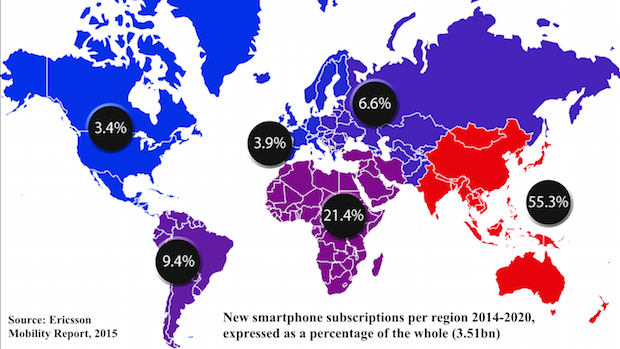
With higher-quality apps and a larger developer base, iOS is undoubtedly the favourite operating system for mobile journalists (mojos) in the Western world.
As Eliot Fitzroy, founder of Epic Tutorials, explained at Mojocon last week, broadcast-quality content can indeed be produced on both Android and iOS, but the fragmentation of Android – the hundreds of different versions running on thousands of different devices – has made it much more difficult for developers to work with this operating system.
Apple, on the other hand, presents a much more appealing space for them. It brings in more revenue, a larger part of its user-base keeps up-to-date with downloading the latest system updates, and they can even take advantage of Swift, Apple’s own popular coding language which has been successful at attracting young coders into the space.
As a result, mobile journalists in Europe and the US have found that iOS will allow them to push the limits with what they can do on one device, without their creativity being limited by buggy apps or complicated workflows.
However, Elizabeth Mearns, senior broadcast journalist, BBC Mobile and Innovations, explained that we are living in an "iOS bubble" which is soon to be popped.
Her mojo training in Africa, Asia and the Middle East has made it clear that "the rest of the world is already on Android", and will remain so, due to the cost of devices in developing countries.
"The middle class in China, for example, are on $10,000 a year, which means the iPhone costs about $2,500 – and in Africa that is over $3,000,” she said.
“Who has got that sort of money? Journalism is not a well-paid job in the developing world, so the broadcasters and the journalists themselves have to use Androids.”
Mearns explained that Asia Pacific, the Middle East and Africa will have a much higher population of people under 30 by 2020 than Europe, according to statistics from Euromonitor International, leading the way for future mobile journalists to be on Android.
“These are the mobile journalists of tomorrow – think about the amount of journalism that is going to happen in these countries in the next generation,” she said.

These developing countries will also grow in total population while that of Europe will fall, said Mearns.
For example, from 2015 to 2050, Africa will have increased in population by 1, 291 million people, but Europe will have decreased by 31.6 million, according to data from the World Bank.
Additionally, the latest Ericsson Mobility Report noted that of the 3.51 billion smartphones around the world, between 2014 and 2020 only 7.3 per cent will be in Europe and the US – the areas that invest predominantly in iOS devices.
Android-dominated Asia, on the other hand, will have over 55 per cent of devices.

“I love my iPhone and do all my mobile journalism on it, but you cannot argue with the figures,” she said, explaining that smartphones will have to cost $300 or less for them to become mainstream in the developing world.
While training abroad, Mearns had to shift her classes away from the high-end mobile journalism she was teaching in the UK, to that of "getting the shot and telling the story digitally" – the fragmentation of Android meant most of the apps she was using were completely useless.
"In the cultures where I have been training, they don't have that 'I'm just not a technical person' attitude – they don't see this split between editorial and technical, and that makes them really enthusiastic and wonderful students to teach," she said.
"Because there are more problems to solve, they are much more innovative."
Watch Elizabeth Mearn's full presentation from MoJoCon here.
Free daily newsletter
If you like our news and feature articles, you can sign up to receive our free daily (Mon-Fri) email newsletter (mobile friendly).
Related articles
- New project InOldNews wants to improve representation in video journalism
- 38 mojo apps from BBC trainer Marc Blank-Settle
- 15 online communities for journalists you should know about
- Ukrainian journalists use smartphones to tell stories of displaced communities
- 10 video editing apps for mobile journalists









